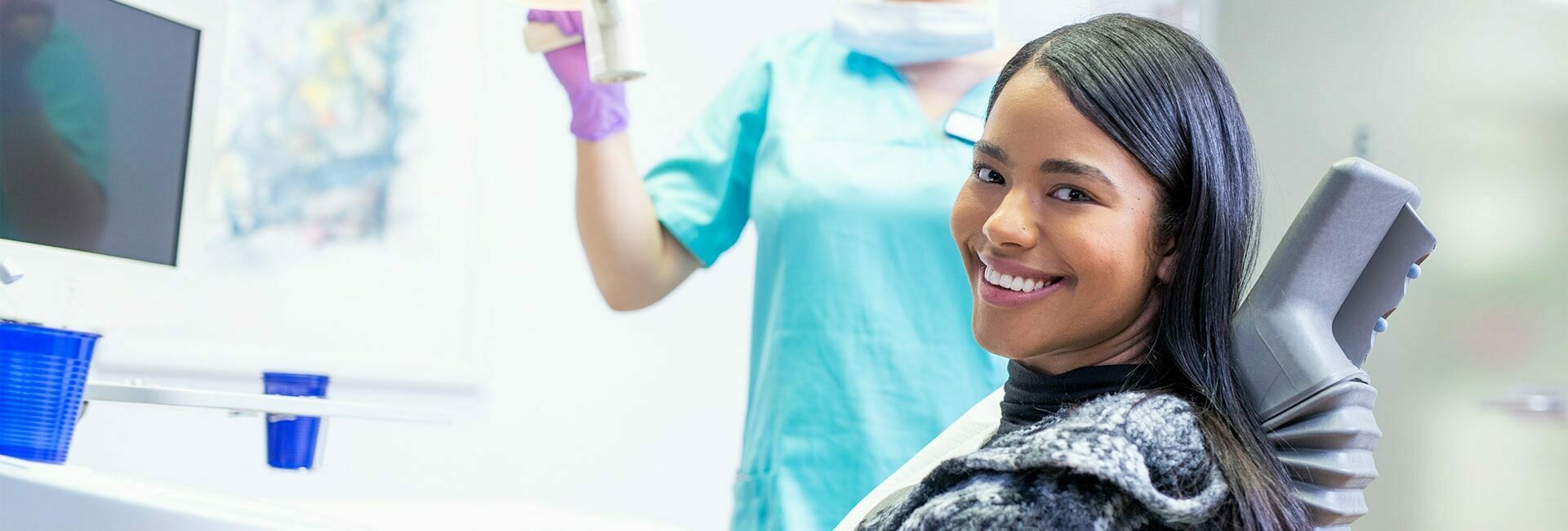
Laughing gas for dental treatments
In recent years and decades there have been major advances in dental medicine. New digital technologies with 3-dimensional X-ray imaging and planning, in addition to minimally invasive surgical techniques have contributed to treatments becoming less invasive and gentler on patients. At the same time, techniques are being continually developed especially with the anxious patient in mind. According to international studies, over 40% of the population in the western world still avoids going to the dentist, solely due to anxiety of experiencing pain whilst having dental treatments.
It is not surprising, then, that more and more dentists are offering treatment options such as laughing gas sedation.
Just by using laughing gas sedation, a simple and safe procedure, dentists can help patients to have a more relaxed and stress-free time in the dentist’s chair.
Laughing gas sedation is an excellent tool that our dentists use to treat anxious patients at our dental practices. We are always happy to help patients to overcome any fears or concerns they might have. This includes using dental sedation in our dental practices to offer patients stress-free, relaxed, and pain-free treatment.

Why laughing gas?
Despite local anaesthesia becoming mainstream in dental medicine, people still associate trips to the dentist with fear and pain. Until not so long ago, patients were not given local anaesthetics in order to numb the areas for treatment in the mouth. The staff working at the Dr. Hager Dental Practices in Konstanz near Kreuzlingen and Bietingen near Schaffhausen have always worked with local anaesthetics, i.e. since opening 38 years ago.
The causes of fearing the dentist comes from that fact that parents often instil a fear of the dentist in their children. For this reason, children expect nothing but fear and pain when visiting the dentist, making it important for patients to feel as ease, and experience a relaxed atmosphere and stress-free treatment process when at the dental practice.
This is why medicinal uses of laughing gas are the cornerstone of dental treatments, becoming increasingly popular with patients.
There are many other types of sedation, in addition to laughing gas. Particularly noteworthy are the following: Propofol sedation (side effects include decreased blood pressure and reduced heart rate); sedation with benzodiazepines such as Dormicum (requires closer monitoring and is more complicated to use than laughing gas sedation).
Sedation should be clearly distinguished from general anaesthesia. Laughing gas sedation is nowadays, however, the method of choice as it has the lowest complication rate and is extremely comfortable for patients.
What does sedation actually mean? And what are the effects of laughing gas?
Sedation refers to a state of relaxation induced by using medication. In the case of laughing gas, this happens using a mixture of oxygen and nitrous oxide (laughing gas). The quantity of nitrous oxide is slowly increased until the desired effects are achieved. The effects of sedation are felt within just a few minutes, with laughing gas having no effect on vital bodily functions, such as breathing or reflexes. Shortly after the first breath is taken, a feeling of improved well-being envelops the patient: this is known as anxiolysis.
Stress and fear disappear, and the patient’s pain threshold becomes raised. At this point, the dentist can continue with numbing the treatment area in the patient’s mouth. For anxious patients and non-anxious patients alike: laughing gas has the same effects on everyone. Even the gag reflex is reduced by nitrous oxide. Our sense of time is also affected, making longer treatments a breeze for patients.

“Some people delay dental appointments due to their fear of the dentist, right up to the point where they are forced into going due to the severe pain they experience. To help calm patients, the Dr. Hager Dental Practices can offer sedation treatments with nitrous oxide. After taking the gas, patients report feelings of well-being and significantly reduced anxiety levels. After having one treatment using the laughing gas, most of our patients decide to do without the gas during further treatments as they manage to build up confidence in the fact that our treatments really are pain-free! In this sense, laughing gas has a type of therapeutic effect. For us as dentists, it is extremely rewarding to be able help patients to rid themselves of their fear of the dentist.“
Dr. Eva Krapf, Dentist at the Dr. Hager Dental Practice
Treatment process with laughing gas
Laughing gas sedation is started with administration of oxygen over a snug-fitting face mask which covers the nose. Dosing of the nitrous oxide gas (N2O, or laughing gas) is then started by gradually increasing the amount added to the oxygen. The resulting feeling is subtle and pleasant. After just a short period of time, around 5 minutes, a level of sedation required for the procedure is reached.
The body only needs to break down around 0.004% of the laughing gas. The remaining 99% is simply breathed back out. This sedated state is maintained for the duration of treatment. The nitrous oxide is stopped once the dentist has finished the treatment procedure. The patient then stays for another 10 minutes or so in the dentist’s chair.
Advantages of laughing gas (N2O)
- Alleviates pain in anxious patients
- Reduces the gag reflex
- Long treatment sessions will seem shorter
- Patients remain completely conscious, compared with the complete unconsciousness that results from general anaesthesia
- Patients are responsive
- Relaxing effect
- No additional medications required
Frequently asked questions
Are there frequent complications with its use?
No, laughing gas used for anxious patients is extremely safe and rigorously tested. Sedation with laughing gas is considered as the safest form of sedation available to modern medicine. Advantages include that fact that is it easy to administer and control, and makes treatments an anxiety-free experience for patients. No allergic reactions to laughing gas have been recorded over the past 150 years.
Can I speak with the dentist during the treatment, e.g. if I do feel some pain?
Yes! You will be completely conscious for the entire duration of the treatment. Only your pain threshold will be affected, becoming higher, as well as the gas making you feel more calm and relaxed. Following sedation with the gas, it is the pain-free injections of anaesthesia that numbs the nerves of the treatment area. General anaesthesia, on the other hand, involves a more intense sedating effect, in which patients are unconscious.
Do I have to take any additional medications?
You do not need to take any medications, neither before nor after treatment with laughing gas.
What causes tooth ache?
A frequent cause is poor oral hygiene. If dental care is not properly ensured on a daily basis, bacteria are able to attack healthy teeth, leading to dental caries (tooth decay). Bacteria work at the teeth, gradually advancing towards their inner layers. Stimuli such as cold water, sweet foods or acids from fruits can reach closer and closer to the dental nerve, leading to the all-too-familiar toothache. Bacteria can similarly cause inflammation of the gums. In this process, it is possible for bacteria to take hold in the gingival crevices (small pockets in the gums), working their way deeper and deeper towards the dental root. In this case too, toothache occurs.